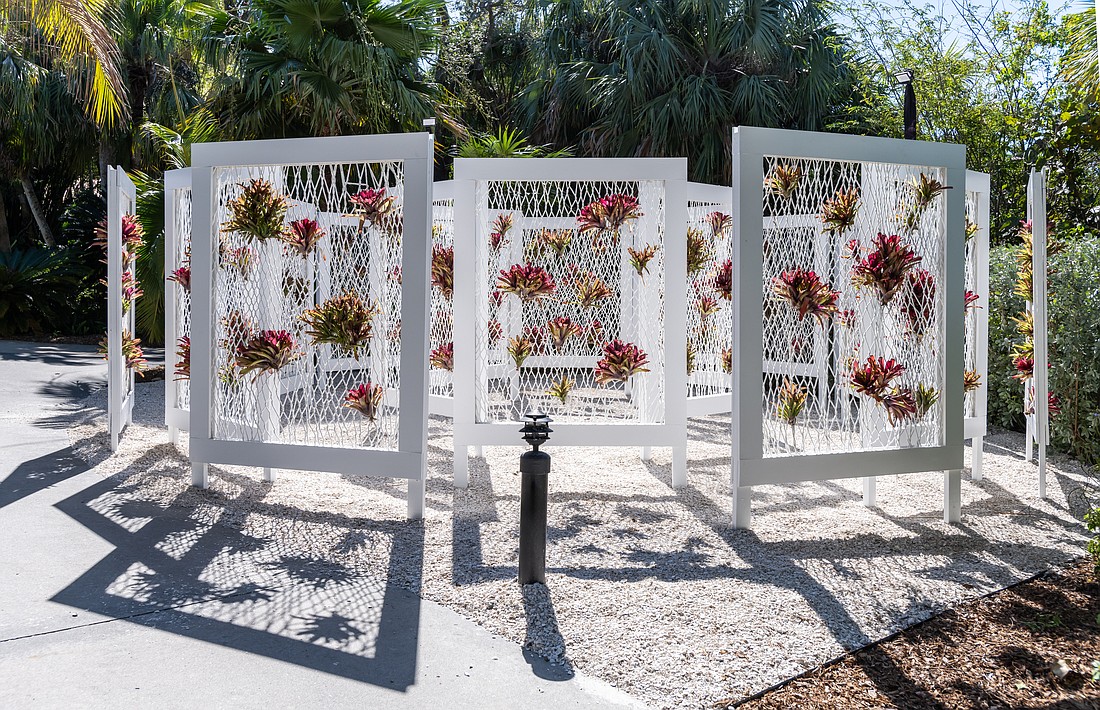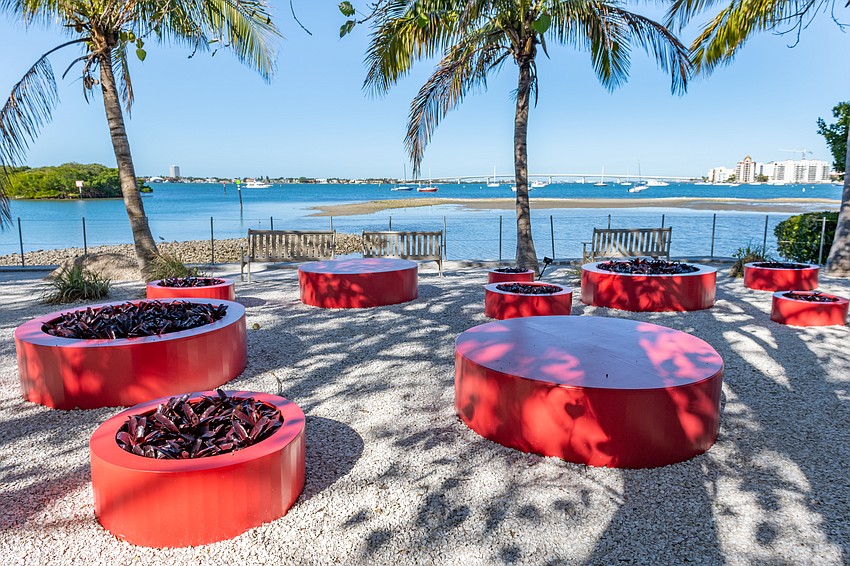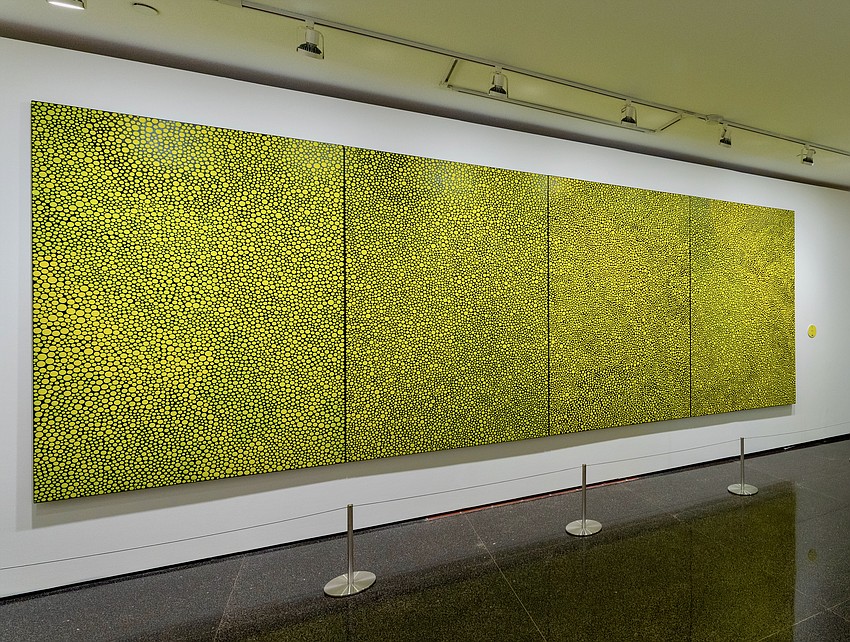- December 26, 2024
-
-
Loading

Loading

With “Yayoi Kusama: A Letter to Georgia O’Keeffe,” Marie Selby Botanical Gardens has managed to get the names of two of the 20th century’s most important female artists in the title of its new exhibition. Imagine if Frida Kahlo were part of the show: There might be riots outside the new welcome center at the 15-acre oasis in downtown Sarasota.
In the two exhibits I’ve seen at Selby’s “Living Museum,” last year’s tribute to Tiffany’s stained glass and a showcase of Sarasota artist John Pirman, art seemed to dominate the Selby landscape more than it does in the latest show.
I confess I was expecting to see more examples of the work of Yayoi Kusama, who is still alive in Japan at age 94, and the iconic female painter Georgia O’Keeffe, who died at age 98 in Santa Fe, near her New Mexico ranch, in 1986.
Astonishingly, these giants of the art world knew each other. When Kusama was in her 20s and living in Japan, she wrote a letter to O’Keeffe seeking her advice about how to develop her art career. You can see a big reproduction of the letter, dated Nov. 15, 1955, inside the Selby Museum of Botany & the Arts.
Kudos to Selby Gardens President and CEO Jennifer Rominiecki and her team for finding this little-known (at least outside the art world) correspondence and making it a hook for a meditative exhibition.
O’Keeffe answered Kusama’s letter and encouraged her to move to New York. The Japanese artist, who features dots in her art and attire, took O’Keeffe’s advice. She moved to New York in 1958 and was part of the city’s pop-art movement, along with Andy Warhol and others, in the 1960s.
Like Warhol, Kusama has straddled the line between fine art and commercialism. She recently created a collection of accessories for Paris-based design house Louis Vuitton, an example of which you can see in the Selby Museum. A year ago, Vuitton covered its Champs-Élysées flagship store with colorful polka dots and erected a giant statue of Kusama with a paintbrush in front of the building. Quelle surprise!
In comparison to such showmanship, Selby Gardens’ Kusama tribute seems understated. Instead of a shout, it’s a whisper. As one would expect in the latest installment in the Jean and Alfred Goldstein Exhibition Series, the plants are the stars of the show.
With playful installations such as plant-filled glass spheres that seem to be floating on water and cacti hanging upside down from the ceiling of the new welcome center, Selby’s horticulturalists are trying to convey one of Kusama’s themes — infinity.
One of her most famous works is called “Phalli Field.” It first appeared in New York’s Castellano Gallery in 1965 and resurfaced in 2016 at the Smithsonian Institution’s Hirshhorn Museum in one of several Infinity Mirror Rooms Kusama has created during her career.
With “Phalli Field,” Kusama started out trying to fill a room with stuffed fabric sculptures made by hand. She decided to use mirrors to achieve repetition of the objects when she realized how time-consuming her original idea would be.
At Selby Gardens, it’s the plants that are doing the heavy lifting. The nonprofit institution, which just celebrated its 50th anniversary, has the largest collection of living epiphytes in the world, as well as thousands of orchids and thousands of bromeliads.
Epiphytes, which are native to Florida, draw moisture and nutrients from the air. As a result, they are the perfect components for an installation inspired by Kusama’s visions of the infinite.
Like her role model O’Keeffe (mentor would be too strong a word even though the two ultimately met in New York City), Kusama has become a fashion icon as well as a legendary artist.
Kusama’s signature red wig and polka-dot infused apparel (some of which include playful perforations) inspirate women of a certain age to dress boldly instead of donning black dresses like Italian widows and party-hopping socialites.

Live colorfully is the ethos of Kusama art and fashion. Why not? Especially after pandemic lockdowns had people wearing yoga pants and sweats for a couple of years or so, even if they put on a suit jacket for a Zoom meeting.
There are cultural commentators who worry that Kusama, who has struggled with mental illness during her lifetime and could be dealing with the side effects of advanced age, is being exploited.
That’s hardly the case at Selby Gardens, which has taken a light touch with its show, even down to the tasteful merchandise in its new gift shop. Kusama’s influence is felt everywhere, but it’s not overwhelming.
With any fad or trend, there’s always the danger of oversaturation. Is there such a thing as too many dots? Perhaps, but as someone who lived through the polka dot craze of the early 1980s, I don’t think we’ve reached peak Kusama yet.
After many years in New Mexico, I don’t have the same feeling about cattle skulls. With help from designer Ralph Lauren’s Southwest-inspired collections featuring O’Keeffe’s image, the cattle skull in her paintings became a necessary objet d’art for anyone decorating according to Santa Fe Style.
It’s an interesting juxtaposition to see one of those skulls hanging in Selby’s lush gardens overlooking Sarasota Bay, not far from circular planting beds bordered by Kusama-like red circles. As they like to say in the art world, it’s an interesting “conversation” between the two artists headlining the Selby exhibition.

If, like me, you want to be wowed by Kusama’s art, you won’t leave Selby Gardens disappointed. Kusama’s “Infinity of Dots,” a four panel-painting, is waiting for you in the back of the botany museum.
The giant piece was previously displayed at The Ringling in 2019 and has been promised as a gift to the museum by Selby trustee Keith D. Monda.
I’ll go back to visit “Yayoi Kusama: A Letter to O’Keeffe” again before it closes June 30. The morning I received a tour from David Berry, Selby Gardens’ chief museum curator, the greenhouse was filled with dot-covered visitors taking selfies next to plant-filled spheres. I’ll wait for the hoopla to die down.
What would Marie Selby think of the polka dot palooza? The no-nonsense gardener gave one of Sarasota’s most popular attractions its start back in the 1920s when she and her husband Bill built a house here.
As her living relatives pointed out during the yearslong debate over the expansion of Selby Gardens’ facilities, “Aunt Marie” would no doubt be gratified that her gardens have been preserved for infinity — unless nature gets the upper hand.